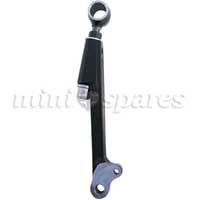
Having put a season and a half of racing on these components I am suitably impressed. The bottom arm design is superb and the finished article extremely well made. The bushes are the icing on the cake.
Accurate suspension set-up is time consuming at the best of times, requiring dogged patience... Read more

These are a direct replacement for the standard bottom arms and will add 1 1/2º of negative camber to whatever the car has as standard – quoted by the manufacturers as being 1º positive, ±1º.
If the car has 1º positive, fitting the negative camber arms will give 1/2º camber. Measuring what the car has with standard arms will help determine what camber setting will be achieved by using C-AJJ3364.
Negative camber helps reduce under steer, thus improving the car’s cornering performance. Altering the car’s ride height also alters the camber angle and so needs setting before considering the fitment of C-AJJ3364 – lowering the car adds negative camber, raising it adds positive camber.
Excessive negative camber will....
Read moreSuitable for all Minis with “dry” rubber cone suspension, including vans, Travellers and Riley/ Wolseley saloons.
General Information
These specialized and RAC FIA homologated suspension components are designed to allow the ride height of all Minis with “dry” suspension to be easily adjusted. In addition, the diameter of the rubber cone support lip is larger than the standard cone to increase effective spring rate. This makes them suitable for fitment in all the following cases:-
ROAD CARS - For load carrying and towing to optimise handling and adjustment.
RALLY CARS - Increase height for rough forestry stages then lower for smooth tarmac.
RACE CARS - Stiffen and lower the suspension as far as possible but can still be raised for bumpy circuits.
Read more
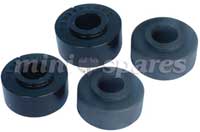
IMPORTANT NOTE
The use of very stiff or hard tie rod bushes on both side of the subframe bracket is most definitely NOT recommended.
Use the hard poly bush (often marked Minispares) on the outside only and the soft rubber bush on the inner side. This is to prevent the tie rod end shearing off through over-stressing when tightening up the retaining nut to achieve the required seating of the retaining washer against the step on the tie...
Read moreTOOL11 is a supremely simple device to use, essentially an oversized vernier calliper.
Although a billiard table like surface is not needed, it is sensible to have the car on something like level ground without any of the wheels in dips or on lumps. Set the steering straight ahead and roll the vehicle back and forth a couple of times to settle the suspension. Resting the gauge on the ground in front of the vehicle with the arms at each end elevated, set the gauge to suit vehicle track width by releasing the two clamp bolts and sliding the two halves apart/together until the desired position is achieved, positioning the measuring tips at half overall wheel/tyre height (i.e. a line drawn horizontally through the hub centre to intersect the wheel/tyre outer edges) on either the wheel rim or tyre wall then pinch... Read more
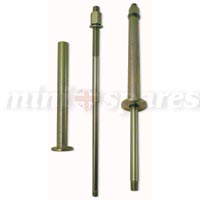
This cone removal tool is for metric threaded rubber cone springs only as fitted from 1976, many earlier cars will have now had metric replacements but check before use.
The outer body has a flange on one end which is the bottom to sit on the bulk head where... Read more

Fitting these brackets will add approximately 1.5 degrees of negative camber to whatever the current setting is, THEY DO NOT give 1.5 degrees of camber. The factory standard settings are quoted as 0.5-2.5 degrees.
After fitment it is imperitive to get the geometry checked, particularly the tracking, The ... Read more
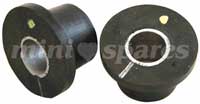
Aftermarket bushes for suspension and subframes have been a topic of conversation for some time now. Many folk have become obsessed about fitting brightly coloured plastic (polyurethane) bushes in place of any rubber bush they can find in the belief they will improve the performance of whatever bush has been replaced. Whilst it is true that polyurethane is harder wearing - and therefore longer lasting - than rubber in many applications it is not necessarily the best material for the application every time. Polyurethane has greater abrasion resistance and is stiffer for a similar hardness, is much cheaper to produce (and therefore sells at lower cost) and can be produced in a wide variety of gaudy colours. Read more
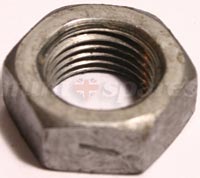
These are to replace the standard bottom arms to facilitate easy adjustment of camber angles.
To fit, pace car safely on axle stands, remove front wheels to ease access, remove tie bar bolt where it joins the bottom arm, break bottom hub ball joint on outer end of arm, then remove the inner arm pivot pin. Adjust the spherical rod end by screwing in or out to set it to a similar length from the centre of the inner pivot point to the centre ... Read more
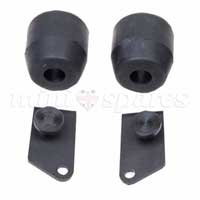
This kit is intended for all hydrolastic minis, although it has been fitted on to dry suspension cars to give improved handling characteristics during motor sport events. Check all clearances of brake pipes and hoses and relocate if necessary. On dry suspension radius arms there is no hole for the bump stop bracket. Read more

1. This is an auxiliary steady bar kit and should not be used to replace any other standard fitment parts that have broken.
2. Remove the radiator support bracket from the radiator and the thermostat housing.
3. Slacken the nut retaining the exhaust manifold at the radiator end of the engine.
4. Remove the three bolts securing the bulkhead blanking plate as shown in the diagram. If the car has a heater pipe as indicated on the diagram then this should be disconnected at the engine. Read more
The crux of the problem is the suggestion that fitting Hi-Los (or some such) will afford you the convenience of winching the ride height up when carrying a larger than normal load
I have been fielding a lot of questions re raising and lowering Minis, mainly from our foreign brethren. The increase in exported Minis to farther shores has revitalized interest in our precious Mini, indeed some new owners have rarely seen one of them and are delighted by it's 'cutesy' character, unbelievable road-holding and the discovery of the plethora of (relatively) cheap, readily available spares and accessories.
One of the first 'tuning tweaks' applied is dumping the car in the weeds. The Internet has also played its part in increasing interest in the Mini. It also provides near-direct links from the beginner ('newbie') or first time owner with those who have extensive knowledge and experience in dealing with our favourite little car. Read more
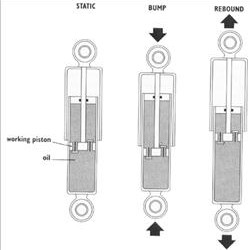
The damper's job is very simple to explain - to keep the tyre in contact with the ground wherever and whenever possible... Read more
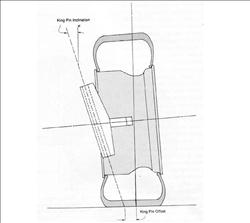
King Pin Inclination (KPI) - the angle is described by a line drawn down through the top and bottom ball-joint (swivel pin) centres and vertical viewed from the front. Extended to ground level, the distance from here to the wheel/tyre... Read more
Adverse Effects of Fitting Wide Wheels part numbers: C-AJJ3359 Terminology used: KPI - King Pin Inclination KPO - King Pin Offset LSD - Limited Slip Differential In the 'Suspension - Terminology' section, I covered what KPI is, as it is an ancient but still oft-used term despite being pretty redundant. Not that it isn't attendant in current cars - it has to be. It's just that the mass car manufacturers have settled the angle at which it is set down to a fairly universally used envelope, and there's nothing the individual can do to alter it without entirely re-fabricating the hubs of drastic surgery on the existing ones. So is, to all intents and purposes, fixed. Even the most technically advanced race teams can do little more than keep a wary eye on what it is doing when playing with suspension set-up. Read more
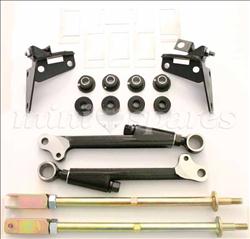
It is baffling to see so many companies advertising mini suspension geometry parts in kits that are a waste of time as they rarely complete the job on either the front or the rear. Read more
Technical lowdown on shock absorbers,what to look for and what to buy Having introduced the fairly unknown Kayaba (KYB) range to the mini market in 1997 I am still amazed how gullible people are when buying cheap dampers. I have tried every type popular type available in the last 35 years, Armstrong including their adjustables, Girling, lockheed, Koni, Spax., Avo, Bilstein,Monroe,Boge,Gabriel and GMax The best to date were probably the very expensive special design Koni adjustables that we had built for the Monte Carlo rally. I also used the spare set on my 8 port car. You get what you pay for? For a non adjustable, Bilsteins rate highly although like the Koni specials are expensive, but you get what you pay for. The essence of a quality damper is to upgrade performance by using more sophisticated higher quality component build in the valving, piston, rod and seals etc along with a performance upgrade to improve the cars road holding. Read more
Suspension - Basic priorities for improved suspension performance. Having studied the 'Suspension - Terminology' article you should now have a ‘job description’ understanding of previously possibly un-comprehended words associated with suspension control. Now - what to do with it? The first thing we need to establish is an order of priority before distributing hard-earned 'beer vouchers' in all directions. Fortunately, this is a good deal less complicated than is generally believed. Despite the five main factors that control the front suspension geometry – kingpin inclination, caster angle, camber angle, track, and bump-steer – we are only really able to alter three of those easily. King-pin inclination is non-adjustable, as it’s a feature of where the swivel-pins are mounted on the hub at the factory. It will alter as other adjustments are made, but we can do nothing easily about correcting/optimising it independently, as these are fixed in position on the swivel hub. Read more

